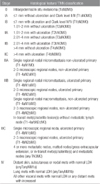Abstract
Purpose
Interferon-α2b using immunotherapy of malignant melanoma is known to increase the microscopic enemies that remain after surgical resection of the tumor to prevent recurrence, disease-free survival and overall survival. Authors in patients with malignant melanoma after surgical resection and high-dose interferon-α immunotherapy treated group of disease-free survival and overall survival compared with the results of the treatment of immune therapy to a preliminary report.
Materials and Methods
From February 2010 to October 2012 at our institution between being diagnosed with malignant melanoma after surgical immunotherapy treated patients were analyzed. Patients was evaluated using the stage AJCC stage IIA 3 cases, IIB 1 cases, IV 1 were as follows. Follow-up period of at least 7 months, and a maximum of 32 months. As maintenance therapy after the first induction therapy group underwent immunotherapy interferon-α of body-surface area per 200,000 IU five times in a week for 4 weeks sedentary and body surface area a total of 48 weeks per week to 100,000 IU three times subcutaneously. These patients for local recurrence and metastases, and distant metastasis were investigated disease-free survival was investigated.
Figures and Tables
References
1. Gray RJ, Pockaj BA, Kirkwood JM. An update on adjuvant interferon for melanoma. Cancer Control. 2002. 9:16–21.
2. Rigel DS, Carucci JA. Malignant melanoma: prevention, early detection, and treatment in the 21st century. CA Cancer J Clin. 2000. 50:215–236.
3. Booher RJ, Pack GT. Malignant melanoma of the feet and hands. Surgery. 1957. 42:1085–1121.
4. Ferlay J, Bray F, Pisani P, Parkin DM. Globocan 2000: Cancer incidence, mortality and prevalence worldwide, version 1.0. IARC cancer base no. 5. 2001. Lyon: IARC Press.
5. Kim DS, Kim BJ. Two cases of malignant melanoma. J Korean Orthop Assoc. 1976. 11:397–402.
6. Lee JL, Kim YH, Lee JM, Kim JD, Kim SJ, Park JH. Molecular analysis of HLA-DR gene expression induced by IFN-gamma in malignant melanoma cell lines. Yonsei Med J. 1999. 40:30–39.
7. Kleeberg UR, Broker EB, Lejeune F, et al. Adjuvant trial in melanoma patients comparing rIFN-alpha to rIFN-gamma Iscador to a control group after curative resection of high risk primary (>3 mm) or regional lymphnode metastasis (EORTC 18871). Eur J Cancer. 1999. 35:suppl 4. A-264. S82.
8. Kirkwood JM, Strawderman MH, Ernstoff MS, Smith TJ, Borden EC, Blum RH. Interferon alfa-2b adjuvant therapy of high-risk resected cutaneous melanoma: the Eastern Cooperative Oncology Group Trial EST 1684. J Clin Oncol. 1996. 14:7–17.
9. Kirkwood JM, Ibrahim JG, Sondak VK, et al. High- and low-dose interferon alfa-2b in high-risk melanoma: first analysis of intergroup trial E1690/S9111/C9190. J Clin Oncol. 2000. 18:2444–2458.
10. Cole BF, Gelber RD, Kirkwood JM, Goldhirsch A, Barylak E, Borden E. Quality-of-life-adjusted survival analysis of interferon alfa-2b adjuvant treatment of high-risk resected cutaneous melanoma: an Eastern Cooperative Oncology Group study. J Clin Oncol. 1996. 14:2666–2673.
11. Eggermont AMM, Kleeberg UR, Ruiter DJ, et al. European Organization for Research and Treatment of Cancer Melanoma Group trial experience with more than 2,000 patients, evaluating adjuvant treatment with low or intermediate doses of interferon alpha-2b. American Society of Clinical Oncology Educational Book. 2001. Alexandria, VA: American Society of Clinical Oncology;88–93.
12. Kirkwood J, Hunt M, Smith T, et al. A randomised controlled trial of high dose interferon α2b for high risk melanoma. Proc Am Soc Clin Oncol. 1993. 12:390.




 PDF
PDF ePub
ePub Citation
Citation Print
Print




 XML Download
XML Download